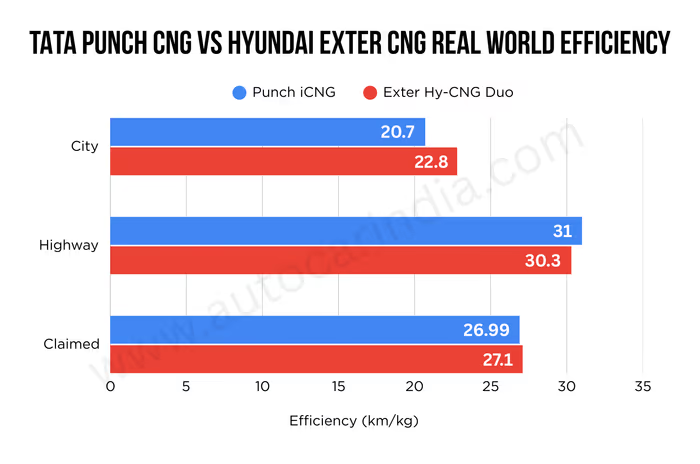Both sub compact SUVs, the Exter and the Punch, come with a dual-cylinder CNG setup, and a claimed ARAI economy figure of about 27km/kg.
The only two subcompact SUVs with a factory-fitted CNG kit, the Tata Punch CNG and the Hyundai Exter CNG, are natural rivals. Both come with a 1.2-litre engine, a dual-cylinder CNG kit and a 5-speed manual gearbox, and their top-spec versions are priced close to one another – Rs 10 lakh for the Punch iCNG Accomplished + S and Rs 9.53 lakh for the Exter Hy-CNG Duo SX Tech. While the ARAI-rated efficiency figures of 26.99km/kg and 27.1km/kg for the Punch CNG and Exter CNG, respectively, are close, we find out if the real-world economy matches.
- Punch CNG has a 74hp engine and weighs 1,181kg
- Exter CNG packs a 69hp engine and weighs 1,093kg
- Both real-world mileage figures are close to the ARAI number
Hyundai Exter CNG vs Tata Punch CNG real world economy results
Punch CNG more powerful, but Exter CNG weighs less
The Exter CNG has a 1.2-litre 4-cylinder engine that produces 69hp and 95Nm of torque on CNG and comes with a 5-speed manual as standard. It weighs 1,093kg, a substantial 88kg less than the Punch CNG, which tips the scales at 1,181kg. However, the Tata SUV has a more powerful engine – a 1.2-litre 3-cylinder unit that makes 74hp and 103Nm of torque. As mentioned previously, a 5-speed manual is standard on the Punch CNG as well.
Exter CNG real world average higher than Punch CNG

In our city fuel efficiency tests, the Hyundai returned 22.8km/kg because of its better drivability, much higher than the Tata’s 20.7km/kg. On the other hand, the Exter’s engine spins 300rpm higher than the Punch’s (3,300rpm) while cruising at 100kph in the top gear. That’s why, in our highway tests, the Punch CNG delivers more – 31km/kg compared to the Exter’s 30.3km/kg.
Considering that the Exter CNG posts an average real-world efficiency figure of 26.55km/kg while the Punch CNG delivers 25.85km/kg, the Hyundai is the more efficient of the two CNG subcompact SUVs. One must note that both models’ real-world figures are quite close to their claimed ARAI numbers.
Autocar India’s fuel efficiency testing
CNG tanks are trickier to fill, and there are several variables, particularly ambient temperature and pump pressure. So, we didn’t opt for our standard tankful-to-tankful methodology. For our real-world test, we emptied their CNG tanks and filled each of them with 2 kilograms of CNG. Then, we drove them within urban confines till they ran out of gas. We repeated the process for the highway test. Throughout the drive, these cars were driven in CNG mode only.
Tyre pressures were maintained based on the manufacturer’s recommendation. These cars were driven on fixed city and highway loops in and around Navi Mumbai, maintaining certain average speeds. Throughout the tests, there was only one person in each car who ran the aircon and other electricals, such as the audio system, indicators and wipers, when required – just like a regular user would. Periodic driver swaps further neutralised variations in driver patterns. We take pride in our testing data, which isn’t merely consistent but also gives users an accurate indication of what they can expect in the real world.
Also see:
Tata Nexon CNG vs Maruti Brezza CNG real world efficiency compared

